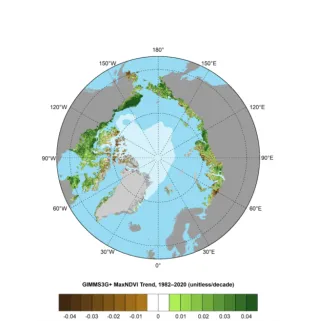The Arctic tundra biome continued to green in the past 10 years with historically high midsummer greenness measurements
Using long-term records from the Advanced Very High-Resolution Radiometer (AVHRR) and Moderate Resolution Imaging Spectroradiometer (MODIS), we show that the yearly maximum tundra greenness (MaxNDVI) has increased across most of the circumpolar Arctic during 1982–2020 and 2000–2021.
In 2020—the most recent year with observations from both AVHRR and MODIS—both sensors observed record high MaxNDVI values for across the circumpolar region, concurrent with record-high Arctic sea surface temperatures and record-low snow cover. We also highlighted how emerging technologies, such as Unoccupied Aerial Systems (UAS), can help better understand the fine-scale drivers and variability of this greening trend. These platforms are useful for elucidating how extreme events and disturbances can lead to contrasting browning patterns in some locations, including how altered moisture regimes can increase vegetation stress. Combining these novel platforms with traditional satellite monitoring allows for the addressing the scaling gap between field- and satellite-observed patterns of vegetation change.
The Arctic tundra biome is a “hotspot” of global environmental change because the vegetation and underlying permafrost-rich soils are strongly influenced by warming air temperatures and the rapid decline of Arctic Ocean sea ice. Starting in the late 1990s, evidence for a pronounced increase in the productivity of tundra vegetation and extended growing season length was observed in global satellite observations. This phenomenon is known as “Arctic Greening”, and has been linked to Arctic’s changing climate, permafrost, seasonal snowpack, and altered sea-ice cover. At the same time, this greening trend is not universal, with some areas showing the opposite “browning” trend in response to disturbance and extreme weather events at local to regional scales. In our NOAA Arctic Report Card essay, NGEE Arctic and others from around the world provide the most recent evidence for a widespread, but not universal, Arctic greening pattern observed through the analysis of long-term satellite observations.
Magnitude of the trend in MaxNDVI (Maximum Difference Vegetation Index) for the 39-year period 1982–2020 based on the AVHRR GIMMS-3g+ dataset. GIMMS-3g+ data for 2021 were not available for this report due to data-processing requirements. The 2020 minimum sea-ice extent is indicated by light shading.
This research was supported by the Director, Office of Science, Office of Biological and Environmental Research of the US Department of Energy under Contract No. DE-AC02-05CH11231 as part of the Next-Generation Ecosystem Experiments (NGEE Arctic) project.
For more information, please contact:
Shawn Serbin
sserbin@bnl.govDaryl Yang
yangd@ornl.gov

